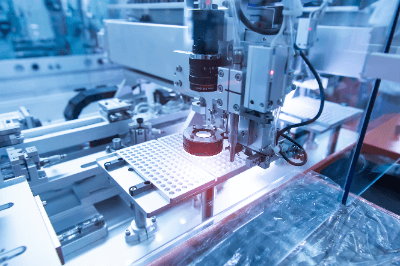What Is an Image Sensor?

An image sensor is a component that converts light information into electrical signals.
Image sensors are the CCD (Charge Coupled Device) and CMOS (Complementary Metal Oxide Semiconductor) sensors used in digital cameras and other photographic equipment.
Image sensors are the “eyes” of a machine. The number of pixels in an image sensor used in a camera refers to the total number of image sensors. Each sensor detects the intensity of light, which is quantified and processed as an electrical signal.
Uses of Image Sensors
Image sensors are mainly used in production lines for mass-produced products. For example, they are useful in production lines for automotive parts, food and medical products, electronic devices, liquid crystals, semiconductors, and plastic products.
The role of image sensors is to provide an alternative to visual inspection by the human eye. They are applied in various tasks such as quantity counting, presence/absence inspections to detect missing products, and visual inspections to identify scratches and defects.
In combination with advanced image analysis technology, they are also used for character identification (OCR: Optical Character Recognition) and 3D measurement. Image sensors are also used in automated driving systems and will continue to be essential devices in the future.
Principle of Image Sensors
The core of an image sensor is a light-sensitive semiconductor (photodiode). This semiconductor senses the intensity of light and stores it as an electrical charge. When light strikes the photosensor, electrons are produced in proportion to the intensity of the light.
The basic principle of image sensors is to use the properties of semiconductors to store electrons and quantify the amount of electrons. In image sensors, there are devices based on different principles, depending on how the electrons stored in the light-receiving element are converted into a signal. The main devices are CCD and CMOS.
In CCDs, the charge is converted to an electrical signal by means of a CCD transfer path. In CMOS, each photodetector has its own amplification circuit (amplifier). Therefore, the charge can be transferred without having to go through multiple photodetectors.
Since CMOS is driven by a single device, it has the advantages of low power consumption and high processing speed. It is also attracting attention for its lower manufacturing cost than CCD.
Other Information on Image Sensors
1. Image Sensor Size
Image sensors come in several sizes. Usually, image quality improves as sensor size increases. The reason is that the larger the sensor size, the more light it can collect.
The greater the range of light that can be captured, or dynamic range, the better the image can be captured with fewer blown-out whites and blacks. In addition, the larger the size of an image sensor with the same number of pixels, the better the image quality, because the light-receiving area per pixel (1 pixel) is larger, which also reduces noise.
2. Role of Illumination in Image Sensors
Illumination is a device that interpolates the image sensor for FA. Illumination is necessary for the image sensor to stably detect a workpiece without being affected by ambient light. The following three lighting methods are common:
Orthoreflective Method
This method illuminates the workpiece from above at an angle and captures the image reflected on the surface of the workpiece. This method makes it easy to obtain contrast between flat and uneven areas of a workpiece, such as a metal plate with uneven surfaces.
Transmission Method
This method illuminates the workpiece from the back and captures the image from the surface. The contours of workpieces with complex shapes can be imaged more accurately.
Coaxial Epi-Illumination Method
This is a method in which the optical axis of the camera is coaxial with the illumination optical axis irradiating the workpiece. The entire workpiece is illuminated evenly and shadows can be minimized.
3. Price of Image Sensor
The price of an image sensor is determined by its “field of view” and “accuracy”.
Field of View
Normally, the larger the number of pixels in an image sensor, the finer objects can be detected. The larger the number of pixels, the larger the size of the sensor and the higher the price.
In addition, processing time tends to increase because of the time required for data transfer. It is important to select a sensor that matches the tact of the system to be operated.
Accuracy
Image sensors with higher pixel counts are more accurate. Depending on the object to be detected, a monochrome sensor or a color sensor may be required, but a color camera is more expensive.